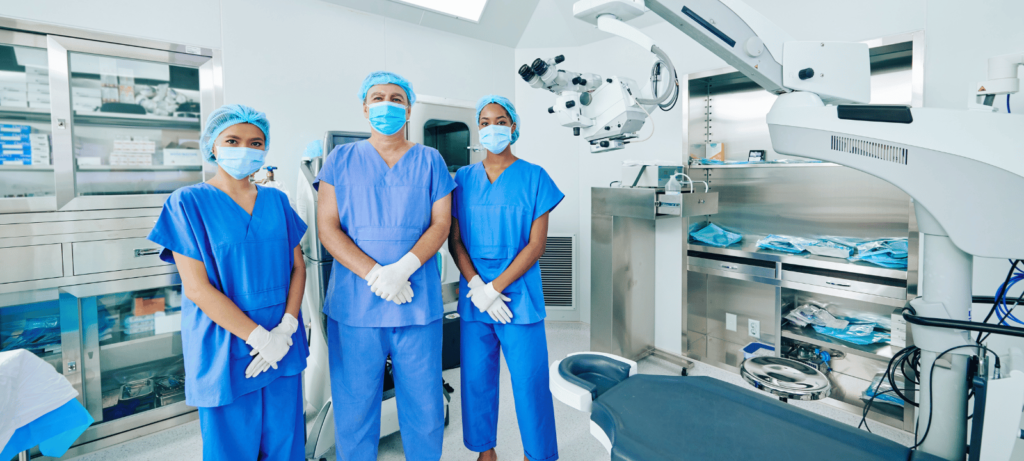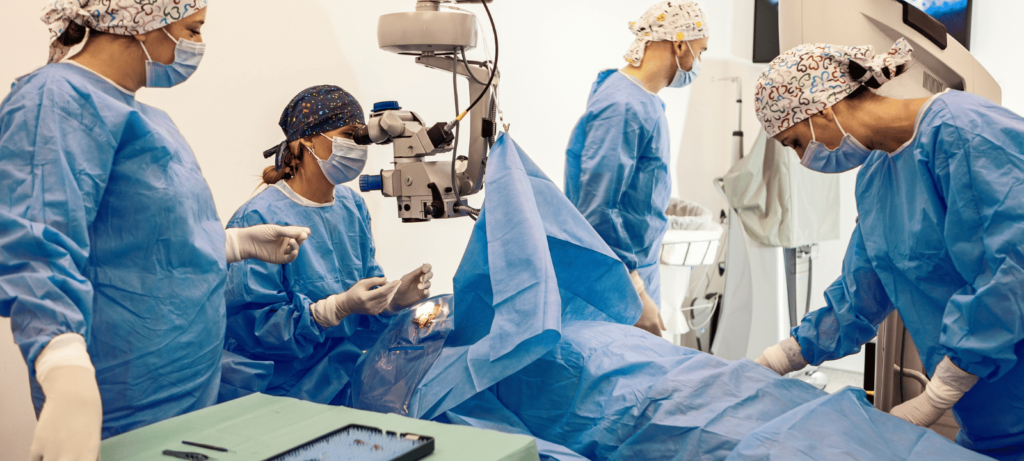Innovations in Laser Technology for Ophthalmic Surgery
We’ll talk about the uses of laser technology in ophthalmic surgery. We will discuss the history of laser technology, its benefits for ophthalmic surgery, the types of lasers used, the latest innovations in laser technology, and the future. Through this blog, we will better understand the importance of laser technology in ophthalmic surgery and its potential for future applications.
History of Laser Technology

The history of laser technology dates back to the mid-20th century when the first laser was developed by Theodore Maiman in 1960. Since then, laser technology has evolved significantly and become an invaluable tool in many fields, including ophthalmic surgery.
A series of milestones have characterized the development of laser technology. In 1962 the first carbon dioxide laser was developed, which could cut through tissue. This marked the beginning of laser applications in the medical field. In 1967, the first laser eye surgery was performed, and in the 1970s, the first laser eye surgery for the correction of nearsightedness was developed.
In the 1980s, the first laser-assisted cataract surgery was developed, and in the 1990s, the first laser-assisted retinal surgery was developed. Since then, the technology has continued to evolve, and new types of lasers have been developed for use in ophthalmic surgery.
Today, laser technology is an integral part of ophthalmic surgery, and it is used to treat various conditions, including glaucoma, cataracts, and retinal diseases. It is also used to perform refractive surgery, which is used to correct nearsightedness, farsightedness, and astigmatism.
Laser technology has come a long way since its inception and continues evolving rapidly. As new advancements are made, the potential applications of laser technology in ophthalmic surgery will continue to expand.
Benefits of Laser Technology for Ophthalmic Surgery

Laser technology has revolutionized ophthalmic surgery, offering numerous benefits to patients. Lasers are highly precise and accurate instruments utilized for various ophthalmic procedures. Using lasers has improved the outcomes of surgeries, allowing for more successful results with less risk of complications. Here are some of the main benefits of laser technology for ophthalmic surgery:
1. Increased Precision: With lasers, precise incisions that are suited to each patient’s requirements may be made. Surgeons can carry out intricate surgeries with higher accuracy and fewer dangers because of this degree of precision.
2. Reduced Bleeding: Lasers can seal blood vessels as they cut, reducing bleeding during the procedure. This makes the surgery safer and more comfortable for the patient.
3. Faster Healing Time: The use of lasers helps to reduce the amount of trauma to the eye area, which can help to speed up the healing process. This can reduce a patient’s time to take off work or other activities to recover from surgery.
4. Improved Visual Outcomes: The precision of laser technology can help to improve the visual outcomes of surgeries, allowing for better vision after the procedure.
5. Reduced Risk of Complications: Lasers can reduce the risk of complications associated with ophthalmic surgery. This can help to reduce the risk of infection and other potential problems.
With less danger and quicker recovery periods, the use of laser technology in ocular surgery has significantly improved the results of operations. This technology has revolutionized the field of ophthalmology, and it continues to be used to improve the safety and efficacy of ophthalmic procedures.
Types of Lasers Used in Ophthalmic Surgery

Ophthalmology has revolutionized because of the development of laser technology, which has given doctors new instruments to carry out intricate and exact surgeries. Lasers are used in many ophthalmic surgeries, including cataract removal, glaucoma treatment, retinal surgery, and refractive surgery. Each type of laser has its unique characteristics and applications.
Argon Laser: The argon laser is a high-powered laser that emits a bright, blue-green light. It is used to treat glaucoma, retinal tears, and retinal detachments. The laser produces a beam of light focused on a target area, destroying the tissue. The argon laser is also used to treat diabetic retinopathy and macular degeneration.
Nd: YAG Laser: The Nd: YAG laser combines neodymium-doped yttrium aluminum garnet (Nd: YAG) crystals and a special dye to produce light. It is used to treat glaucoma, retinal tears, and retinal detachments. Additionally, macular degeneration and diabetic retinopathy are also treated with it. The Nd: YAG laser is less potent than the argon laser but can treat deeper tissue.
Excimer Laser: The excimer laser is a type of laser that uses ultraviolet light to make precise cuts in the eye. It is used in refractive surgery, such as LASIK and PRK, to reshape the cornea and correct vision problems. It is also used to treat corneal scars, astigmatism, and cataracts.
Diode Laser: A small semiconductor produces a light beam in a diode laser. It is used in various ophthalmic surgeries, including cataract removal, glaucoma treatment, and retinal surgery. The diode laser is handy for treating small, hard-to-reach areas.
These are just a few of the lasers used in ophthalmic surgery. Each type of laser has its unique characteristics and applications. Depending on the type of procedure being performed, the surgeon will choose the appropriate laser to ensure the best results. Lasers offer precision, accuracy, and safety, making them an invaluable tool in ophthalmology.
Latest Innovations in Laser Technology for Ophthalmic Surgery

The world of ophthalmic surgery has seen much advancement in recent years, particularly in laser technology. Ophthalmic surgeons now use laser technology as a necessary tool since it helps them carry out a variety of delicate and complex operations more accurately and precisely. The possibility for better surgical results increases as laser technology develops. Here, we’ll discuss the most recent developments in ocular laser surgery and explain how they enhance clinical results.
One of the most exciting recent developments in laser technology is femtosecond lasers. Femtosecond lasers use ultra-short light pulses to create tiny gas bubbles in the eye. These bubbles are used to make precise incisions in the cornea, allowing surgeons to perform various procedures, including cataract surgery, glaucoma surgery, and refractive surgery. It has been shown that using femtosecond lasers may increase operation precision while lowering the risk of complications.
Another important innovation is the use of wavefront technology. Wavefront technology uses a laser to measure how light passes through the eye. This information is then used to create a detailed map of the eye, which can be used to customize the laser treatment for each patient. Wavefront technology has been shown to improve the accuracy of laser treatments, resulting in better visual outcomes.
Finally, adaptive optics is becoming increasingly common in ophthalmic surgery. Adaptive optics uses a laser to detect and correct any aberrations in the eye, resulting in improved vision. This technology benefits patients with conditions such as astigmatism, which can be challenging to treat with conventional methods.
These are just a few of the latest innovations in laser technology for ophthalmic surgery. As technology advances, so too will the potential for improved surgical outcomes. By utilizing the latest laser technology, ophthalmic surgeons can provide their patients with the best possible care.
Future of Laser Technology in Ophthalmic Surgery

As technology advances, so does the potential of laser technology in ophthalmic surgery. Laser technology has already revolutionized how ophthalmic surgeons perform procedures, and the future of laser technology looks even brighter. In the future, lasers may be used to treat a broader range of conditions, and surgeons may be able to perform more precise and complex procedures.
The potential of laser technology in ophthalmic surgery is vast. Lasers can treat various eye conditions, from cataracts to glaucoma. Lasers can also treat more complex conditions, such as retinal detachment, macular degeneration, and even corneal transplantation. As technology advances, the possibilities for laser treatments in ophthalmic surgery become even more exciting.
The latest advancements in laser technology have allowed surgeons to perform more precise and complex procedures. For example, femtosecond lasers can make incisions with greater precision and accuracy. This technology can also be used to perform laser-assisted cataract surgery, allowing surgeons to remove cataracts with greater accuracy and minimal discomfort to the patient.
The future of laser technology in ophthalmic surgery looks even brighter. New developments in laser technology allow surgeons to treat a broader range of conditions while minimizing the risks associated with surgery. For example, laser technology is now used to treat glaucoma, allowing surgeons to reduce intraocular pressure without requiring invasive surgery.

The possibilities for further advancements in laser technology are almost limitless. In the future, lasers may be used to treat a broader range of conditions, and surgeons may be able to perform more precise and complex procedures. As technology advances, the potential of laser technology in ophthalmic surgery looks even brighter.
The future of laser technology in ophthalmic surgery is an exciting one. As technology advances, the potential of laser technology in ophthalmic surgery looks even brighter. As new developments in laser technology are made, surgeons can treat a broader range of conditions while minimizing the risks associated with surgery. The future of laser technology in ophthalmic surgery looks very bright indeed.
Conclusion
In conclusion, the advancements in laser technology have revolutionized the field of ophthalmic surgery, providing many advantages that have transformed how we approach eye procedures. From its humble beginnings in the 1960s to the cutting-edge innovations of today, laser technology has consistently improved precision, efficiency, and safety in ophthalmic surgeries.
At Sasco Hill Surgery Center, we recognize the pivotal role that laser technology plays in our commitment to delivering top-notch eye care. As technology evolves, our dedication to incorporating the latest advancements ensures that our patients receive the best possible treatment. With a bright future ahead, we do not doubt that laser technology will remain an indispensable tool in the world of ophthalmic surgery, further enhancing the quality of care provided at Sasco Hill Surgery Center.
